Asus ROG Strix GeForce GTX 1660 Ti review: GTX is back with a vengeance - dowdywoulty

At a Glance
Expert's Military rating
Pros
- Outstanding 1080p and solid 1440p gambling
- Tremendous effective customs cooler
- Utile double-BIOS profiles optimized for thermals and noise
- Outstanding features and build quality
Cons
- No RTX irradiate trace capabilities
- $50 premium in price-sensitive section
- Very generous graphics card
Our Verdict
Nvidia's GeForce GTX 1660 Cordyline terminalis is the best 1080p GPU you can buy, and Asus's varied and potent ROG Strix design makes IT evening better, albeit at a significant price premium.
Best Prices Now

Not Available
GTX is back, baby. After being kicked to the curb in favou of a newfangled "RTX" blade that signifies the inclusion body of dedicated RT and tensor cores that enable real-time ray tracing and AI-enhanced gaming, Nvidia's tried-and-true lynchpin returns for the release of the GeForce GTX 1660 Ti graphics card. Yes, that means this $280-plus GPU lacks the fashionable capabilities of its bigger siblings, like the GeForce RTX 2060. But by ditching all the superfluous hardware, Nvidia was capable to focalise the GTX 1660 Ti's efforts on just plain kicking screw in games.
And it succeeds, friends.
The GeForce GTX 1660 Ti delivers outstanding 1080p and solid 1440p play performance connected a equation with last-gen's $380 GTX 1070, without the massive price increase witnessed in its RTX-laden cousins—it's only if $20 more what the GTX 1060 launched at. This card beats the snot prohibited of AMD's Radeon RX 590, even though its start price is $10 lower. It's a winner. Let's take over a look at the Asus ROG Strix GTX 1660 Ti, a custom-cooled, heavy overclocked version of the GPU that costs $330.
Nvidia GeForce GTX 1660 Ti glasses and features
Contempt costing hardly $20 to a higher degree the 6GB GTX 1060, the brand-new GTX 1660 Ti comes moneyed with much to a greater extent computer hardware under the bonnet—much CUDA cores, many L1 cache, more texture units, faster GPU and memory clock speeds, more transistors built using the more advanced 12nm FFN manufacturing process, you name it. Deuce known features remain identical, notwithstandin: a 120-watt TDP and the 6GB of onboard computer memory content, though the GTX 1660 Ti gets a monolithic bandwidth upgrade by moving from GDDR5 to GDDR6.
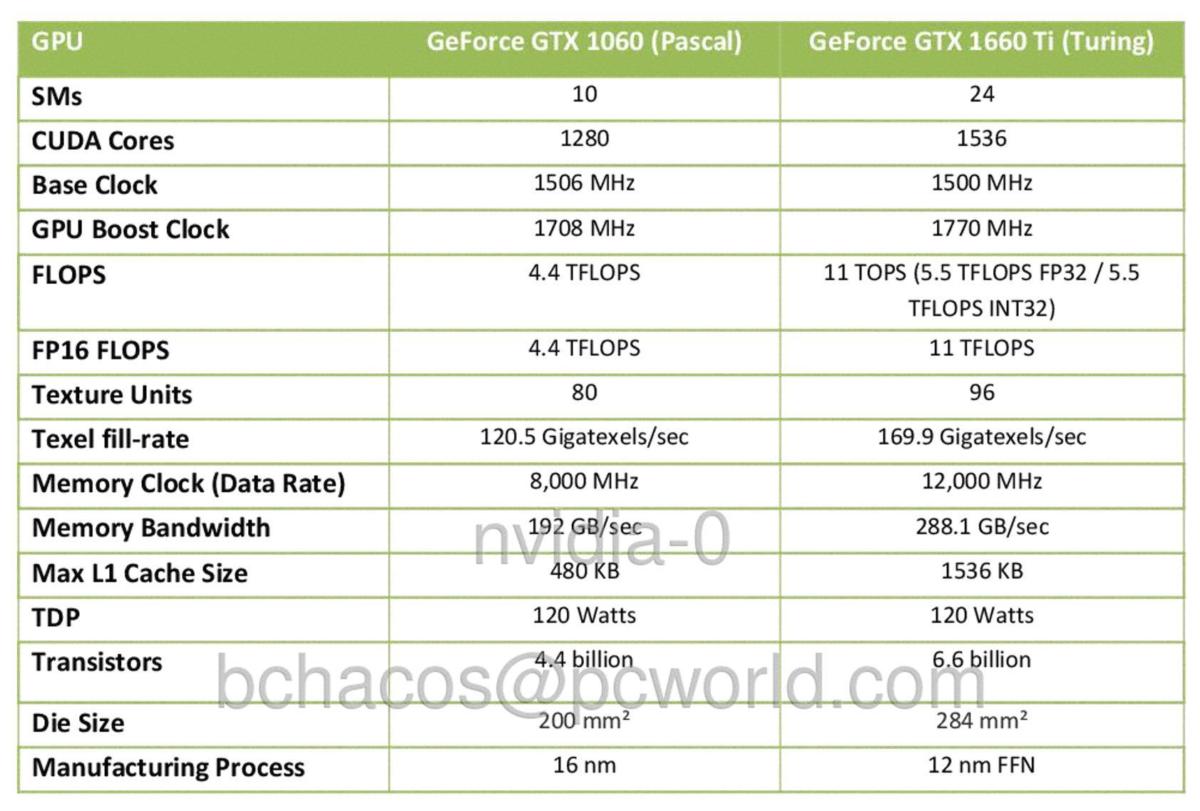 Nvidia
Nvidia The retentivity isn't the only upgraded hardware. The CUDA cores at the heart of the Turing GPU inside the GTX 1660 Ti (and its RTX brethren) received a significant overhaul that helps Nvidia's new graphics card game outpace their "Pascal" GPU-based predecessors. Almost notably, Nvidia added a new integer pipeline (INT32) alongside the floating point grapevine (FP32) traditionally accustomed process shading. This lets the GPU manage floating point and non-floating point instructions concurrently, rather than stalling the shading process while the GPU tackles whole number tasks, which used to be the norm. The new capabilities help Darkness of the Tomb Raider tend over 50 percent faster on the GTX 1660 Ti than it did along the 6GB GTX 1060, Nvidia says—a claim verified by our personal functioning examination.
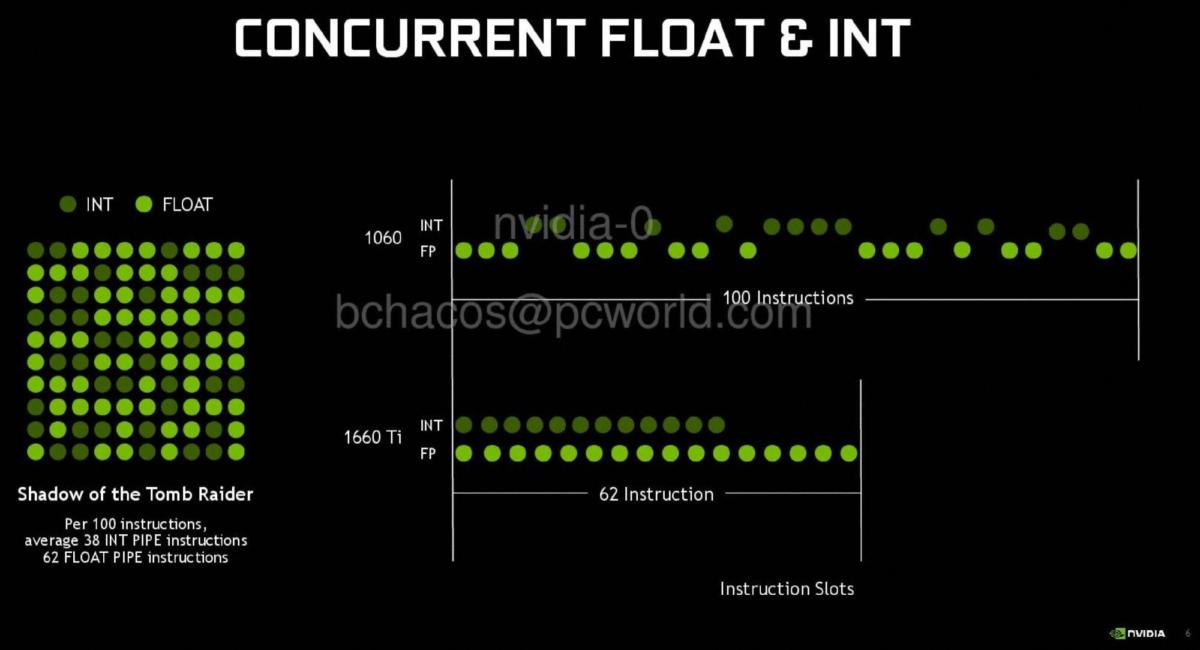 Nvidia
Nvidia Turing GPUs also include support for variable rate shading, a technology that allows antithetic parts of the pictur to be rendered at varying fidelity levels for raised performance. It also provides a unified cache computer architecture that gives Turing almost three times more available L1 store than the Pascal GPUs in the GTX 10-series, with twice every bit much bandwidth and lower latency. Those features help boost performance in Wolfenstein II and Call of Obligation: Dark-skinned Ops 4, respectively, away 50 percent compared to the GTX 1060, Nvidia says.
For a untold more in-deepness plunge into the changes in these new-look CUDA cores, sound out our deep-dive into Nvidia's Alan Turing GPU architecture. You'll instruct a pile about the ray tracing and tensor CORE capabilities of RTX GPUs there, too.
Of course, as a modern GeForce card, the GTX 1660 Te can take reward of Nvidia's rich software ecosystem, including features suchlike Ansel super-screenshots, ShadowPlay television capturing, automatic game optimization via GeForce Experience, and G-Sync monitor compatibility. Nvidia GPUs can now play nice with AMD FreeSync monitors too.
Asus ROG Strix GTX 1660 Ti specs and features
While the GeForce GTX 1660 Te volition herculean-launch today, February 22, with multiple versions lendable from all the wonted suspects starting at $280, the specific graphics card we reviewed is the $330 Asus ROG Strix GTX 1660, a luxurious model with a heavy overclock, a ferocious custom cooler, and extra features galore. Everything you'd expect from a ROG Genus Strix card, in other words! Here's a view its spec shrou:
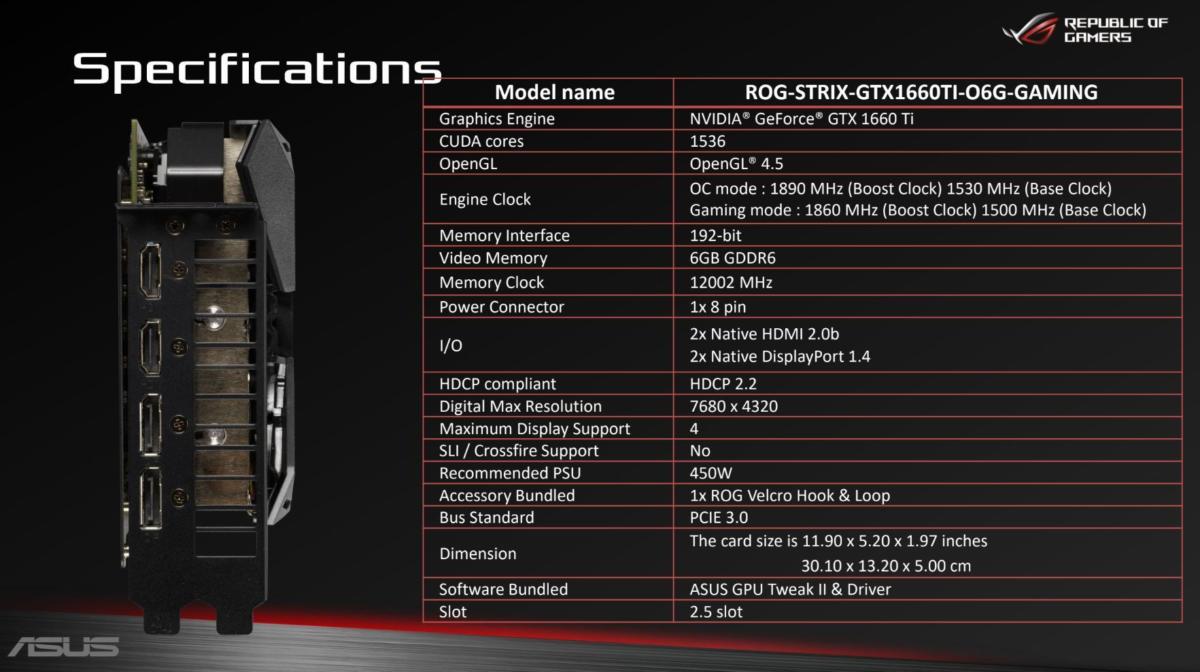 Asus
Asus Out of the box, the ROG Strix is rated for a 1,860MHz boost clock, a 90MHz increase over the GTX 1660 Ti's character speeds. Downloading Asus's W. C. Handy GPU Tweak II overclocking computer software and activating the one-button OC mode ups that to 1,890MHz. Merely you don't need to do that: The large, effective cooler connected the ROG Strix allows the card to hover consistently between 1,935MHz and 1,950MHz in our games testing, because Nvidia's GPU Boost algorithm automatically pushes clock speeds further As thermal headroom allows. GPU Tweak II lets tinkerers fine-tune things justified far with blue-collar overclocking controls, too.
The three-fold-slot Asus ROG Strix GTX 1660 Ti comes with iii RGB-well-lighted mechanism fans, a beefy heatsink, a metal-braced design, and a fetching full-length backplate that mirrors the aesthetic on other modern Strix releases.
 Asus
Asus Asus is particularly pleased its Auto-Extreme automated manufacturing process. "Traditionally, soldering of through with-hole and surface-mounted components needs to comprise performed in separate stages," Asus's reviewers guide explains. "Machine-Extreme Technology allows all bonding to be completed in a single pass, reducing thermal strain on components and avoiding the use of harsh cleaning chemicals. The remnant result is inferior environmental impact, lower manufacturing power consumption, and a many reliable merchandise."
Beyond the bulky heatsink and buff trio, the ROG Strix GTX 1660 Ti packs additional features for better thermal public presentation. Strix GPUs include "MaxContact Applied science," a fancy way of expression that the heat broadcaster contacting the GPU is precision-machined to be 10X blandish than handed-down designs, allowing for improved stir up dissipation. The card also comes with a pair of Asus FanConnect II fan headers. Any PWM case fans connected to the headers can mechanically oppose to the GPU's temperature, picking upward speed when temperatures rise and slowing down when your GPU is idle. In our prior experience, it's especially effective if you use FanConnect with a front case fan pointed at the Strix.
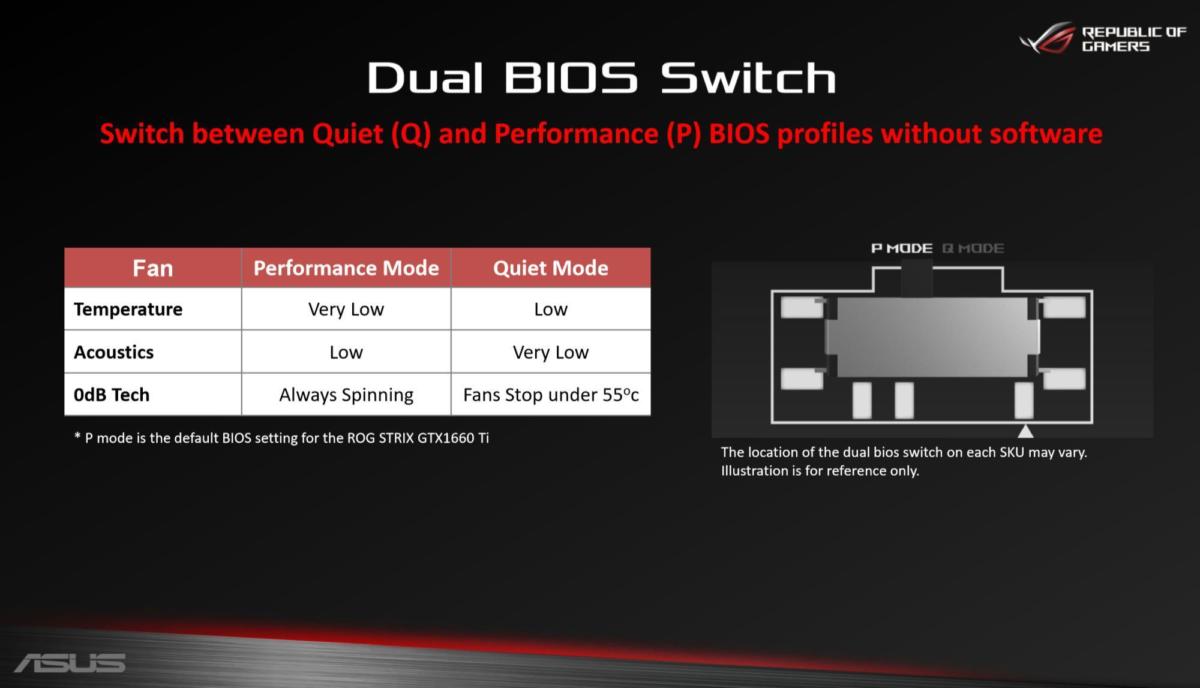 Asus
Asus Total information technology all up and the ROG Strix GTX 1660 Cordyline terminalis's custom cooling system solution is almost frightfully effective, as you'll see later. That potency gives the graphics card some interesting versatility, which we initiative witnessed in the Asus ROG Strix RTX 2080: A dual-BIOS switch that lets you choose between Performance and Quiet profiles.
That's nothing new in swankier graphics card game, simply the Strix's knock-down cooler lets both profiles deliver identical performance in games, and that's a rarity. Instead, the Operation BIOS ramps high the fans to keep temperatures consistently below 60 degrees Celsius. Functioning mode runs surprisingly quietly, but the dedicated Quiet mode optimizes for acoustics and runs virtually silently. Unpretending features a much inferior militant fan curve, and the fans go idle if the GPU core temperature drops to a lower place 55 degrees Celsius.
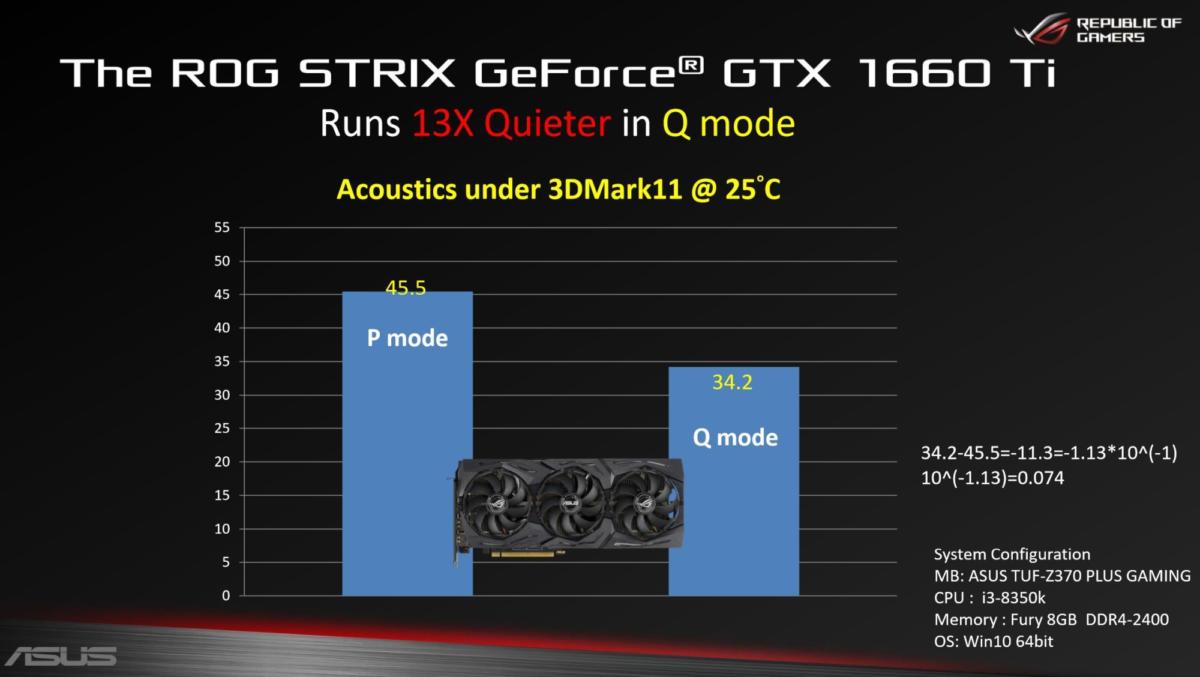 Asus
Asus According to Asus, the Operation BIOS is 16 percent cooler than the Quiet BIOS, while Quiet is 13X quieter. Both are tremendously effectual at their given goals in practical habituate. This is a zealous feature for discerning gamers.
Next to the dual-BIOS switch, you'll recover a dedicated hardware button for disabling the ROG Strix GTX 1660 Si's RGB firing—a thoughtful touch. That lighting can be controlled aside Asus's Glory Synchronize software. The port loadout for the GeForce GTX 1660 Atomic number 2 will vary from model to model, but the ROG Strix comes panoplied with a pair of DisplayPorts and a pair of HDMI 2.0b connections.
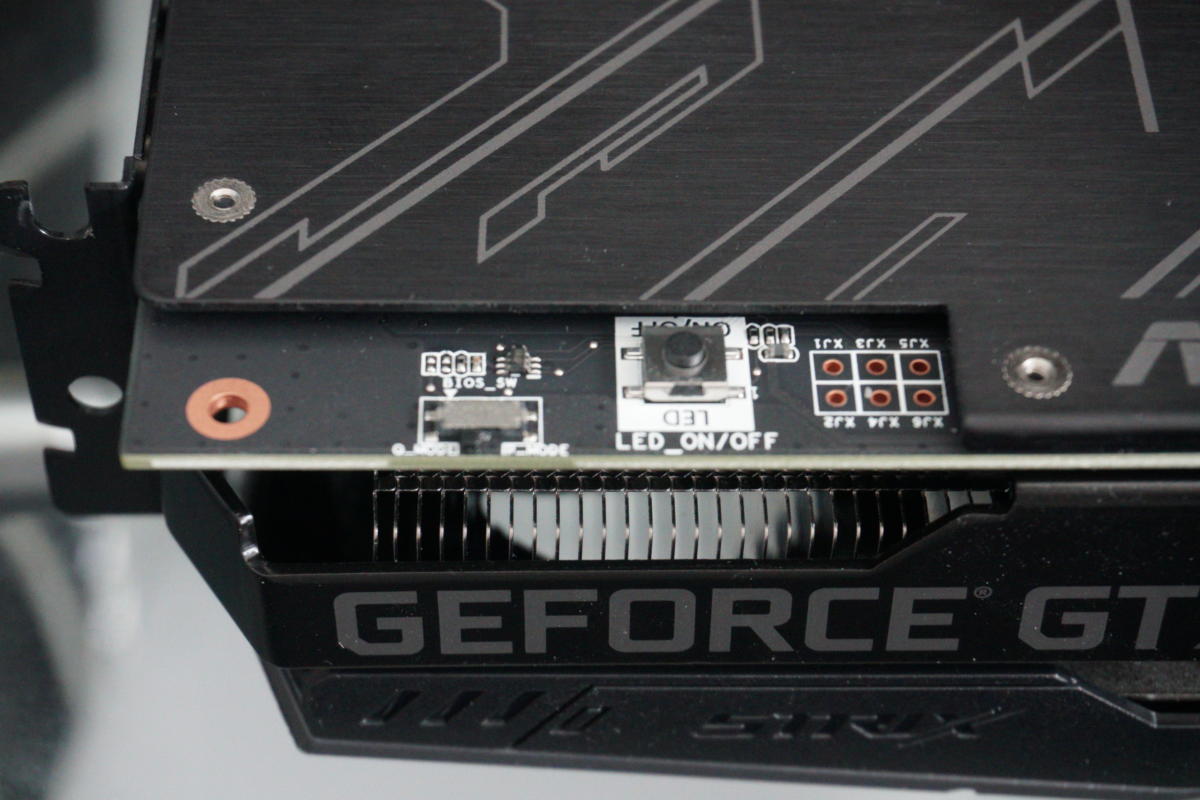 Brad Chacos/IDG
Brad Chacos/IDG The dual-BIOS permutation (left-hand) and LED energizing button (right).
While we'rhenium reviewing Asus's about expensive and glamorous GTX 1660 Ti offering nowadays, the company is releasing several SKUs crosswise its ROG Strix, Asus Dual, and Asus Phoenix brands with varying speeds and have sets:
- ROG-Genus Strix-GTX1660TI-O6G-GAMING – $329.99
- ROG-STRIX-GTX1660TI-A6G-Gambling – $324.99
- ROG-STRIX-GTX1660TI-6G-GAMING – $319.99
- DUAL-GTX1660TI-O6G – $309.99
- Twofold-GTX1660TI-6G – $304.99
- PH-GTX1660TI-O6G – $284.99
- PH-GTX1660TI-6G – $279.99
Got it? Good. Allow's hit the test bench.
Adjacent page: Our test system, benchmarks get
Our test system
Our dedicated graphics card test system is jammed with some of the quickest complementary components usable to put some potential carrying into action bottlenecks squarely on the GPU. Almost of the hardware was provided past the manufacturers, but we purchased the cooler and storehouse ourselves.
- Intel Core i7-8700K processor ($360 on Amazon)
- EVGA CLC 240 closed-loop liquid cooler ($120 on Amazon)
- Asus Maximus X Hero motherboard ($260 on Amazon)
- 64GB HyperX Predatory animal RGB DDR4/2933 ($318 for 32GB on Amazon)
- EVGA 1200W SuperNova P2 power supply ($180 on Amazon)
- Corsair Crystal 570X RGB case, with front and top panels removed and an supernumerary rear winnow installed for built airflow ($160 along Amazon)
- 2x 500GB Samsung 860 EVO SSDs ($78 ea. on Amazon)
We're comparing the Asus ROG Strix GTX 1660 Ti against its predecessor, an overclocked EVGA version of the 6GB GTX 1060, besides as the GTX 1070 Founders Variant and the ray of light tracing-surefooted $350 GeForce RTX 2060 Founders Variation. To see how it stacks up against the Radeon rivalry, we're also included performance results from the $260 Sapphire Radeon RX 590 Nitro+ (which launched at $280 in Nov), the $400 Radeon Vega 56, and the Asus ROG Strix variant of the Radeon RX 580. Galore Radeon RX 580 models can systematically be found for under $200 connected cut-rate sale these days, even in 8GB variants.
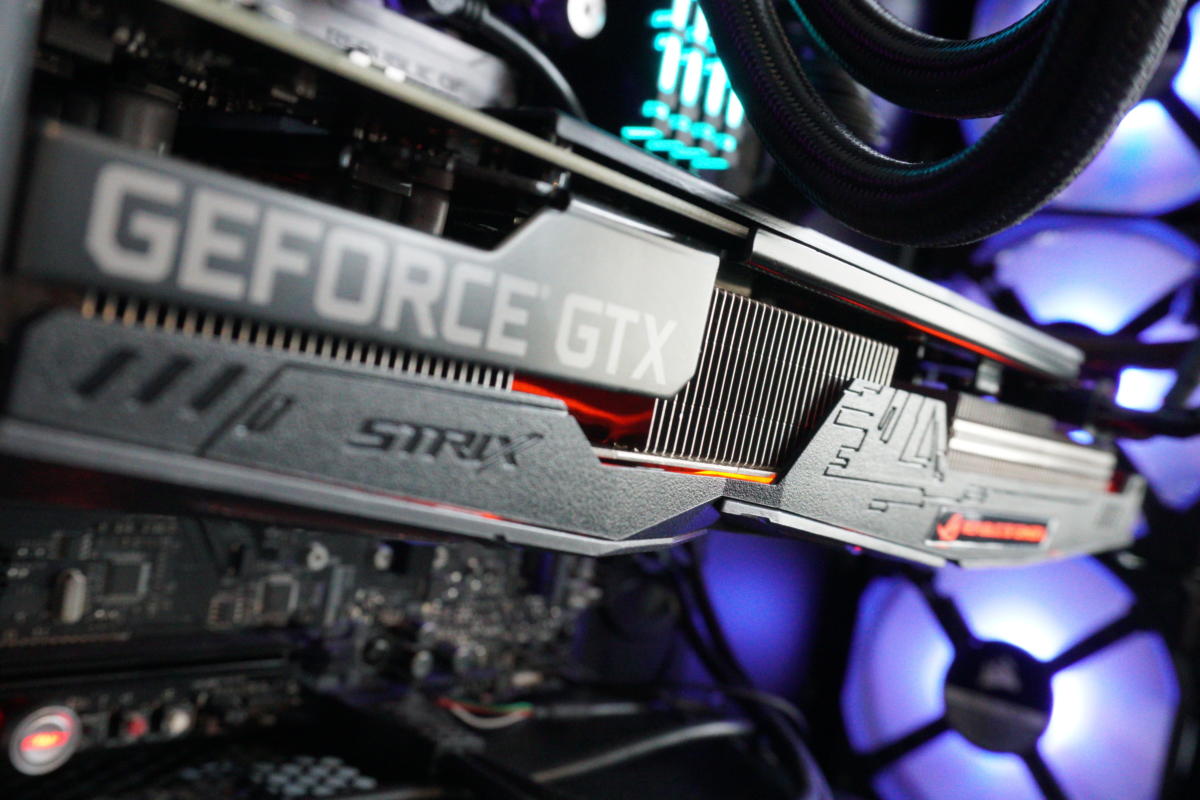 Brad Chacos/IDG
Brad Chacos/IDG Each unfit is tested using its in-lame benchmark at the highest possible graphics presets, with VSync, frame rate caps, and all GPU vendor-specific technologies—like AMD TressFX, Nvidia GameWorks options, and FreeSync/G-Sync—injured, and temporal anti-aliasing (TAA) enabled to push these high-end cards to their limits. If anything differs from that, we'll advert it. We run each benchmark at to the lowest degree ternary times and tilt the average resultant for each test.
We limited our testing to 1080p and 1440p resolutions, As satisfying 4K gaming is mostly out of the reach of this class of card. We benchmarked the Asus ROG Genus Strix GTX 1660 Cordyline terminalis victimization its default Performance BIOS.
Asus ROG Strix GTX 1660 Ti gaming benchmarks
Peculiar Brigade
Let's kick things off with Strange Brigade ($50 on Humble), a cooperative 3rd-person shot where a team of adventurers blasts through hordes of mythological enemies. It's a technological showcase, built just about the next-gen Vulkan and DirectX 12 technologies and infused with features like HDR reenforcement and the ability to toggle asynchronous figure on and forth. It uses Rebellion's custom Cerulean railway locomotive. We test with async compute off.
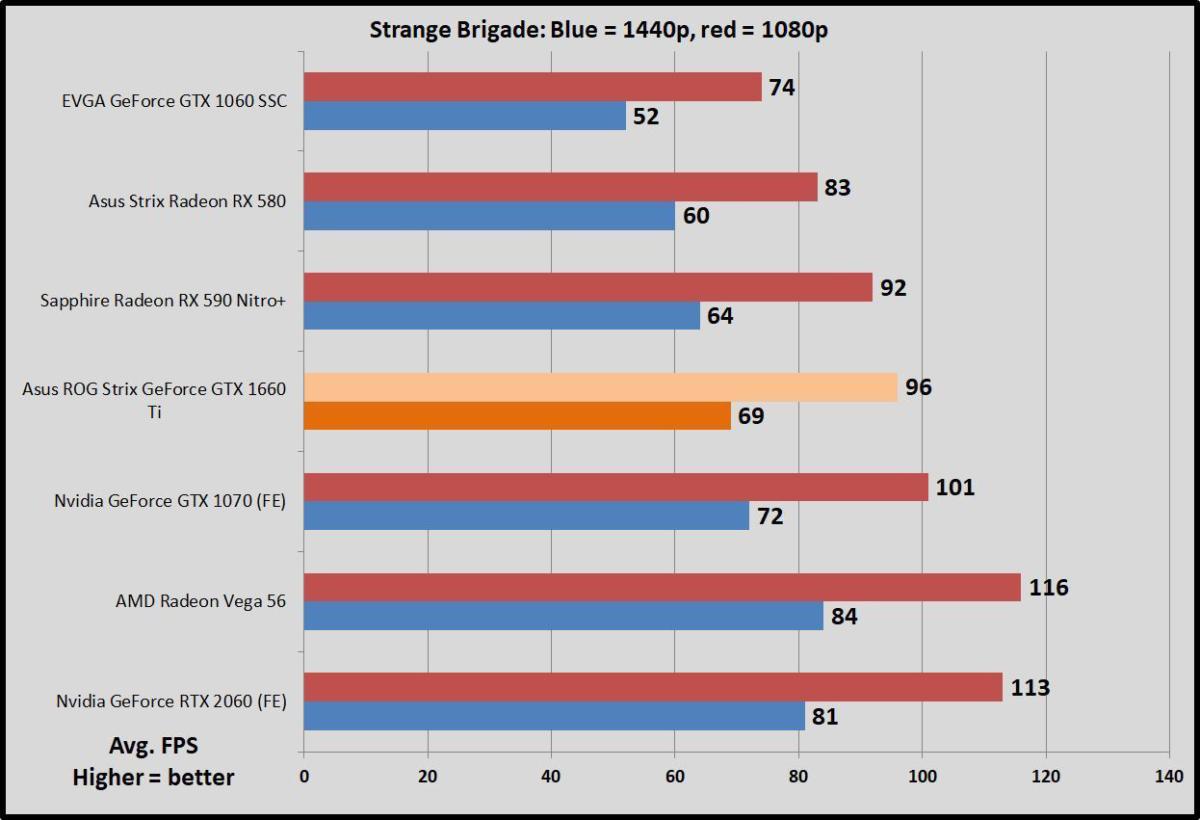 Brad Chacos/IDG
Brad Chacos/IDG The Asus ROG Genus Strix GTX 1660 Ti's performance rivals the GTX 1070's and surpasses the GTX 1060's by about 30 percent, hovering some the 100-fps mark at 1080p resolution. IT also manages to eke out a win over the similarly priced Radeon RX 590 despite Strange Brigade's preference for AMD cards, which you can see in guiltless effect by comparing the results of the GTX 1070 and Vega 56.
The pricier, RTX-enabled GeForce RTX 2060 Founders Variation is perceptibly quicker than the GTX 1660 Ti, which makes sense because the graphics visiting card packs in more CUDA cores and other tech. It'll maintain its lead over the ROG Strix in every benchmark.
Trace of the Tomb Raider
Shadow of the Tomb Raider ($60 on Humble) concludes the reboot trilogy, and it's dead gorgeous—symmetric the progressive GeForce RTX 2080 Ti scantily manages to average 60 Federal Protective Service with all the bells and whistles overturned along at 4K resolution. Lawful Enix optimized this game for DX12, and recommends DX11 only when you're using older ironware or Windows 7, indeed we test thereupon. Shadow of the Grave Raider uses an increased version of the Foundation locomotive that also powered Rise of the Grave Raider.
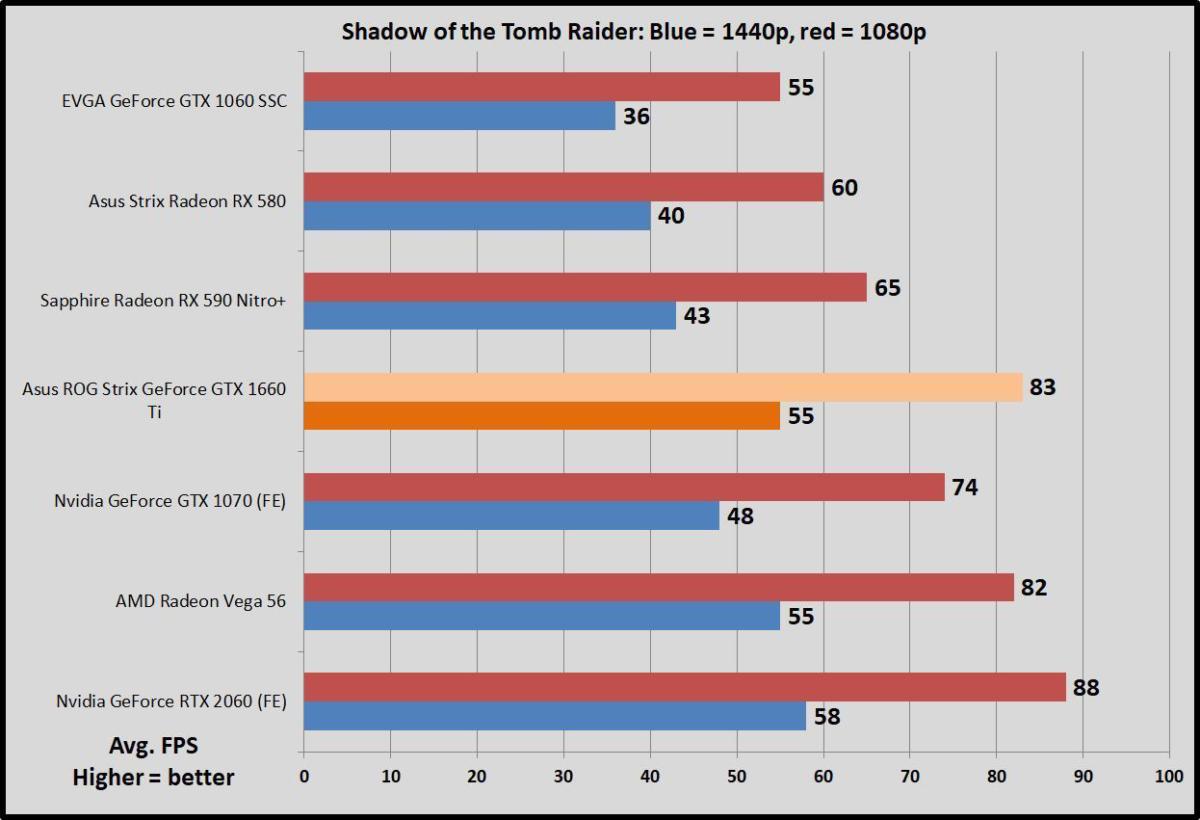 Brad Chacos/IDG
Brad Chacos/IDG Remember how Nvidia said tweaking shading performance to scarper whole number and floating point operations concurrently gives the GTX 1660 Ti a big boost in Shadow of the Tomb Raider? It wasn't lying. It blows away the GTX 1060 to the tune of 50 percent-summation, smashes the Radeon RX 590, and even the GTX 1070 can't keep pace.
Far Cry 5
Finally, a DirectX 11 game! Far Cry 5 ($60 on Humble) is powered by Ubisoft's long-established Dunia engine. It's just as gorgeous American Samoa its predecessors, and even more fun. We'll likely substitute IT in our suite with the newer Far Cry: Brand-new Dawn shortly.
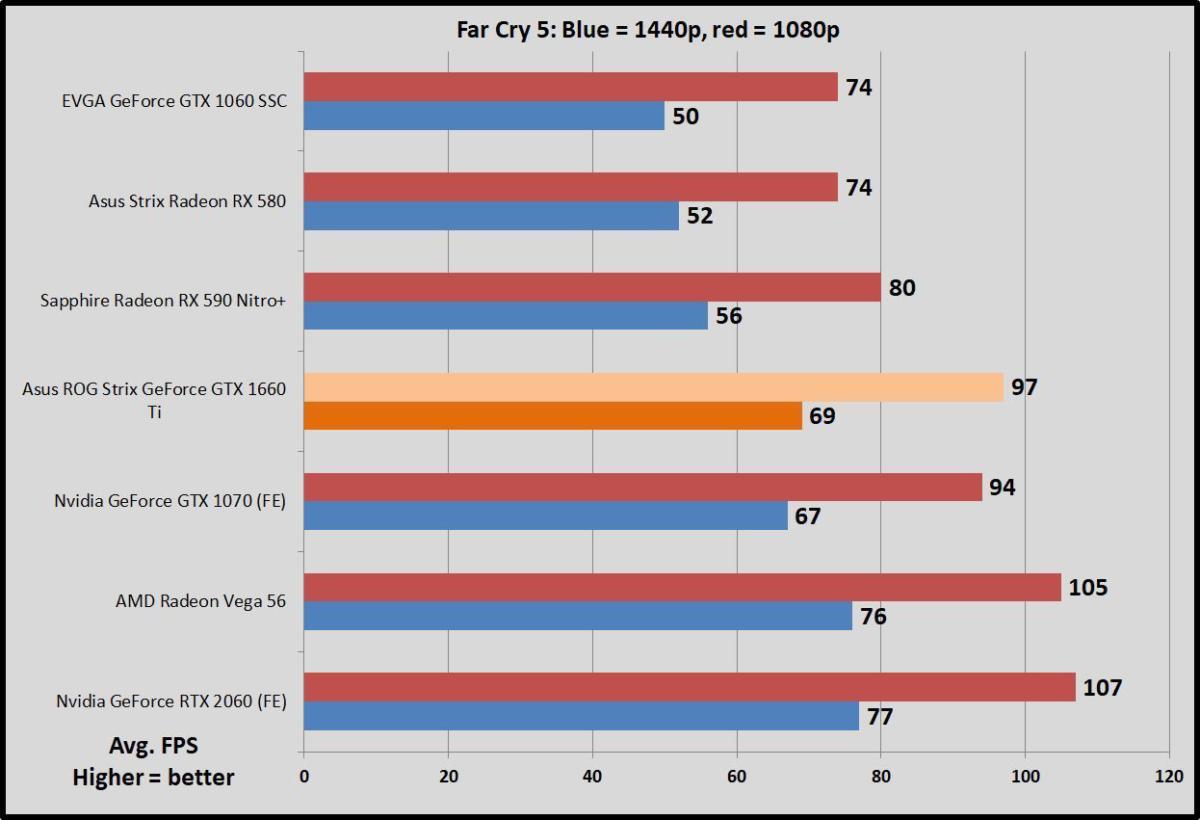 Brad Chacos/IDG
Brad Chacos/IDG It's other massacre. The GTX 1660 Te beatniks the Radeon RX 590 aside over 20 percent, and the GTX 1060 by over 30 percent.
Next Sri Frederick Handley Page: Play benchmarks continue
Ghost Recon Wildlands
Ease up, Crysis. If you crank all the graphics options capable 11, like we do for these tests, Ghost Recon Wildlands ($50 on Humble) and its AnvilNext 2.0 railway locomotive absolutely melts GPUs. Ghost Recon Wildlands also prefers Nvidia's GPU computer architecture generally.
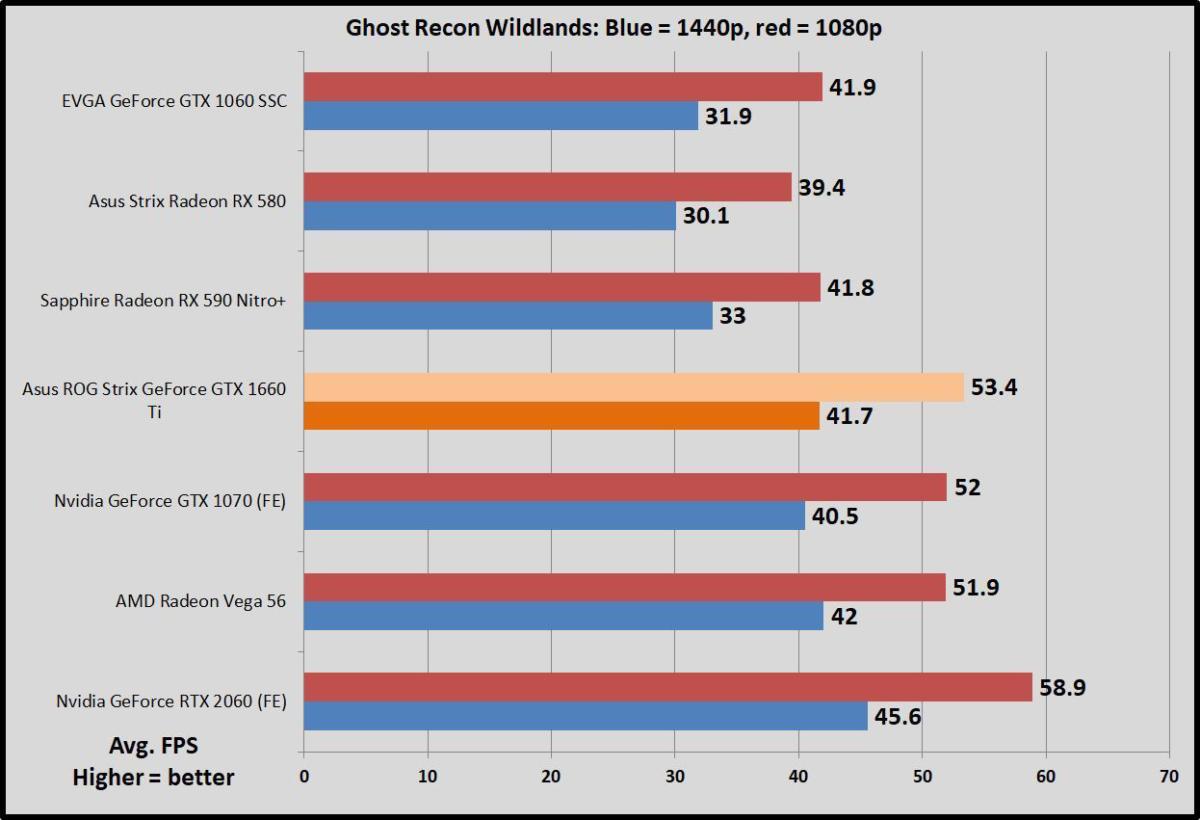 Brad Chacos/IDG
Brad Chacos/IDG Once again, the ROG Strix blows away the GTX 1060 and AMD's likewise priced Radeon RX 590, trading blows with the GTX 1070. And once again, the GeForce RTX 2080 is even faster, though its leading is slighter here.
Middle-earth: Shadow of War
Middle-earth: Shadow of War ($50 on Humble) adds a strategic layer to the series' elated core gameplay curl, adapting the Nemesis system to let you create an army of individualized Orc commanders. It plays wish a champ along Personal computer, too, thanks to Monolith's custom LithTech Firebird engine. We use the Extremist graphics preset but drop the Shadow and Texture Quality settings to High to debar exceeding 8GB of VRAM usage in our examination scenario, since graphics cards that exceed 8GB of capacity are rare indeed.
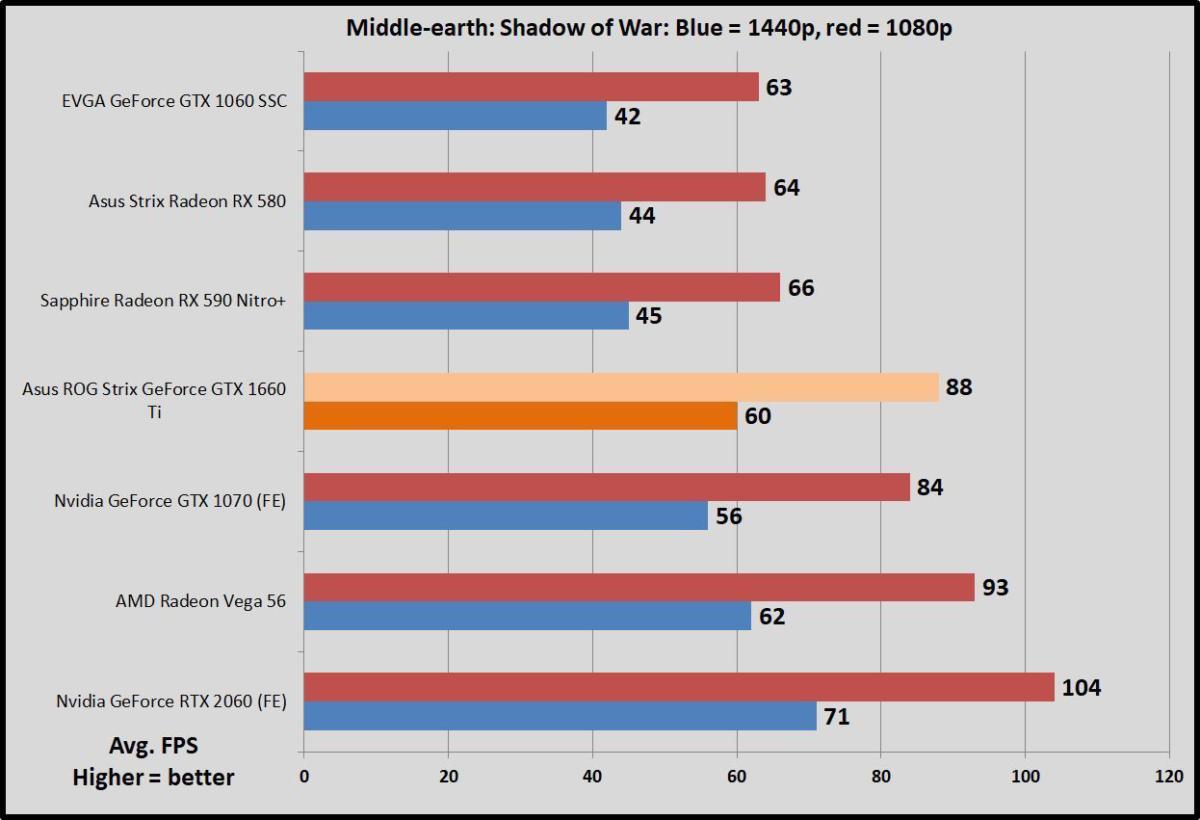 Brad Chacos/IDG
Brad Chacos/IDG The GTX 1660 Ti doesn't even get 8GB of computer storage capacity, though that doesn't affect its performance. It again stays on even footing with the GTX 1070 and Radeon Vega 56, and wrecks its predecessor likewise as AMD's Polaris GPU-based card game.
F1 2018
The stylish in a long bank line of successful games, F1 2018 ($60 on Humble) is a benchmarking gem, provision a wide align of some graphical and benchmarking options—devising information technology a much more tried and true option that the Forza series. It's built on the one-fourth edition of Codemasters' oleaginous-smooth Ego game locomotive engine. We tryout two laps on the Australia course, with clear skies.
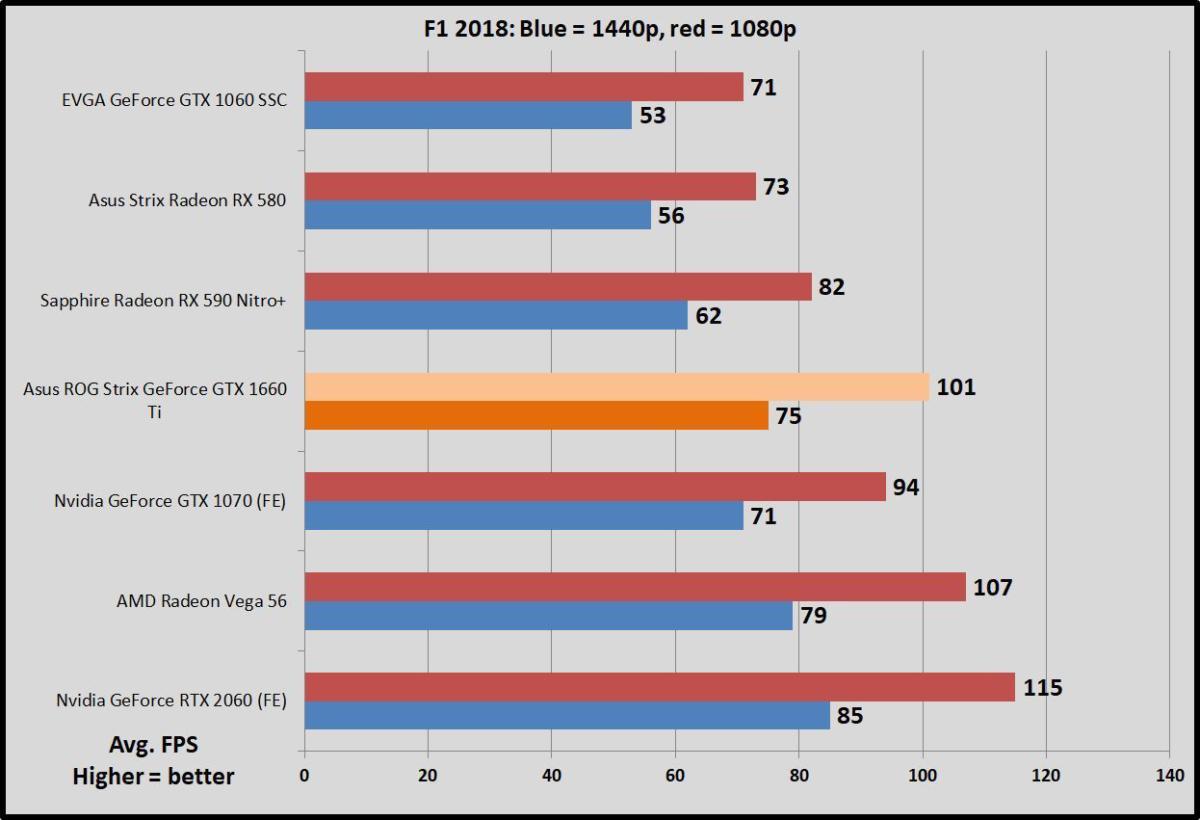 Brad Chacos/IDG
Brad Chacos/IDG The GTX 1660 Ti surpasses a 100-FPS medium at 1080p resolution. Not even the GTX 1070 does that. AMD's Vega 56 is a little faster, but costs $400.
Adjacent page: Play benchmarks continue
Ashes of the Singularity: Escalation
Ashes of the Singularity ($40 on Humble) was one of the selfsame first DX12 games, and it stiff a pin-bearer for the technology to this 24-hour interval thanks to the extreme scalability of Oxide Games' next-gen Nitrous engine. With hundreds of units onscreen simultaneously and some serious nontextual matter personal effects in play, the Softheaded preset give notice make graphics card game sweat. Ashes runs in both DX11 and DX12, only we mental test only in DX12, Eastern Samoa it delivers the unexceeded results for both Nvidia and AMD GPUs.
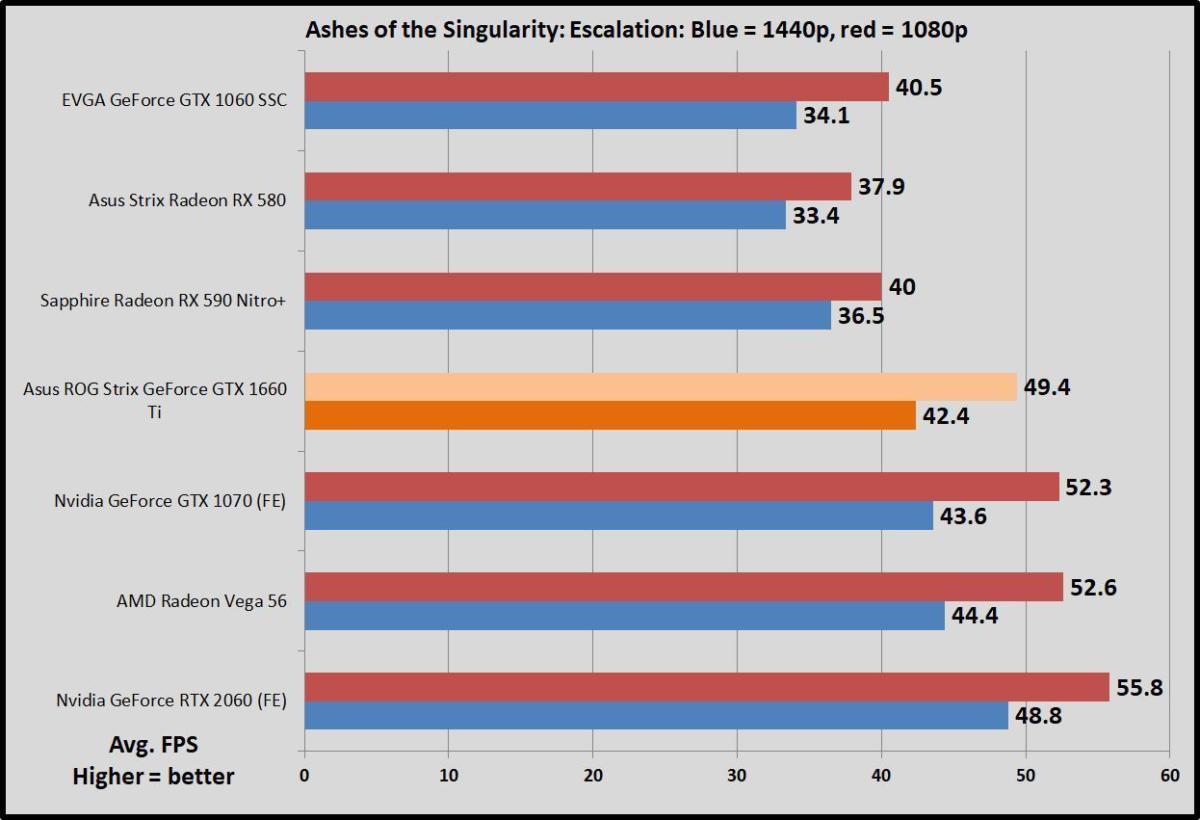 Brad Chacos/IDG
Brad Chacos/IDG The song remains the same here. The ROG Strix hangs with the GTX 1070 and Vega 56, and beats the GTX 1060 and similarly priced Radeon RX 590 away about 25 percent.
GTA V
We're going away to wrap things improving with a couple of older games that aren't in truth visual barn-burners, but still high the Steam charts all the time. These are games that a lot of populate play. First up: Grand Theft Auto V ($30 on Humble) with entirely options overturned to Very High, complete Front Graphics options except extended shadows enabled, and FXAA. GTA V runs on the Madness railway locomotive and has conventional substantial updates since its initial set up.
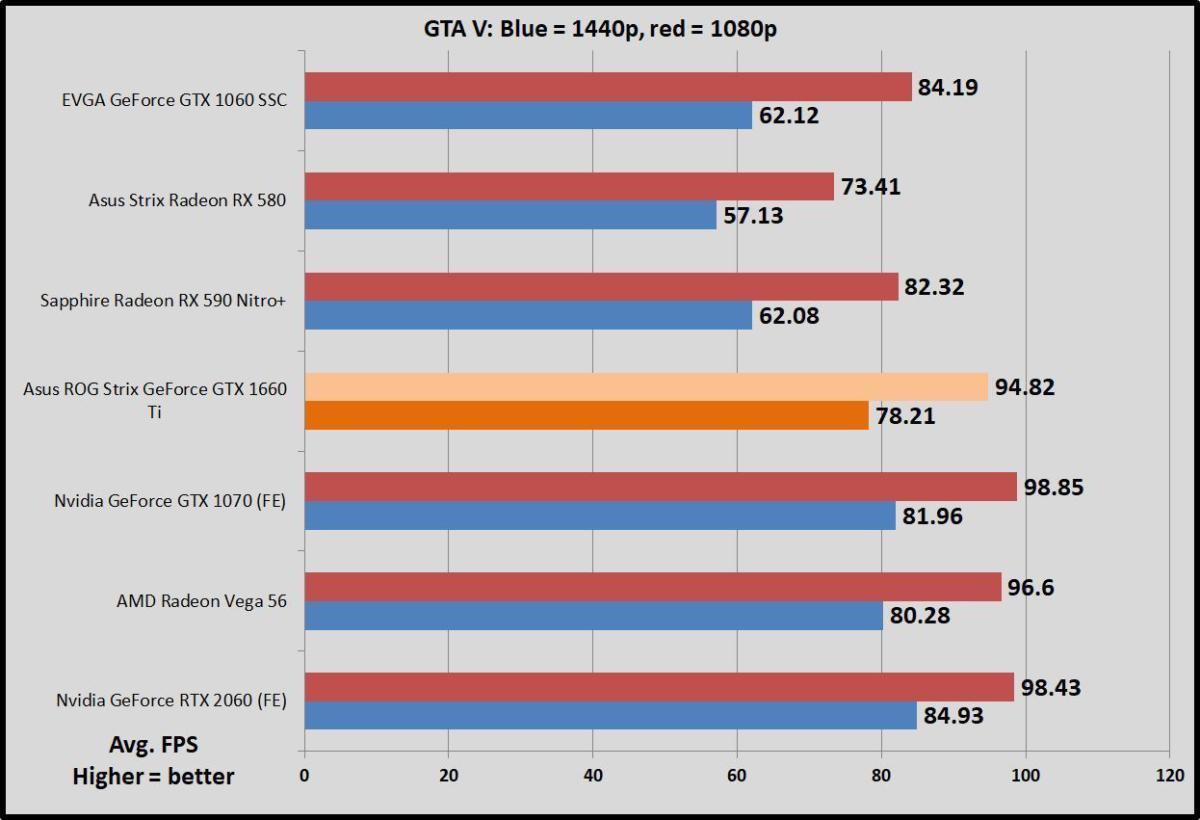 Brad Chacos/IDG
Brad Chacos/IDG Surprise! The ROG Strix GTX 1660 Cordyline terminalis is a little slower than the GTX 1070 Hera, which is a trend we've seen in Nvidia's RTX cards, too—something about GTA V's design prefers the older Pascal architecture. It's just scarcely slower than the pricier options, though, and it still womps on the Radeon RX 590 and GTX 1060, especially as the settlement increases.
Rainbow Half-dozen Siege
At last, let's take a peek at Rainbow Sextet Siege ($40 on Humble), a game whose audience just now keeps on healthy, and one that still feels like the only truly next-gen shooter aft all these years. Like Ghost Recon Wildlands, this game runs on Ubisoft's AnvilNext 2.0 engine, but Rainbow Six Siege responds especially well to graphics cards that lean on async work out features.
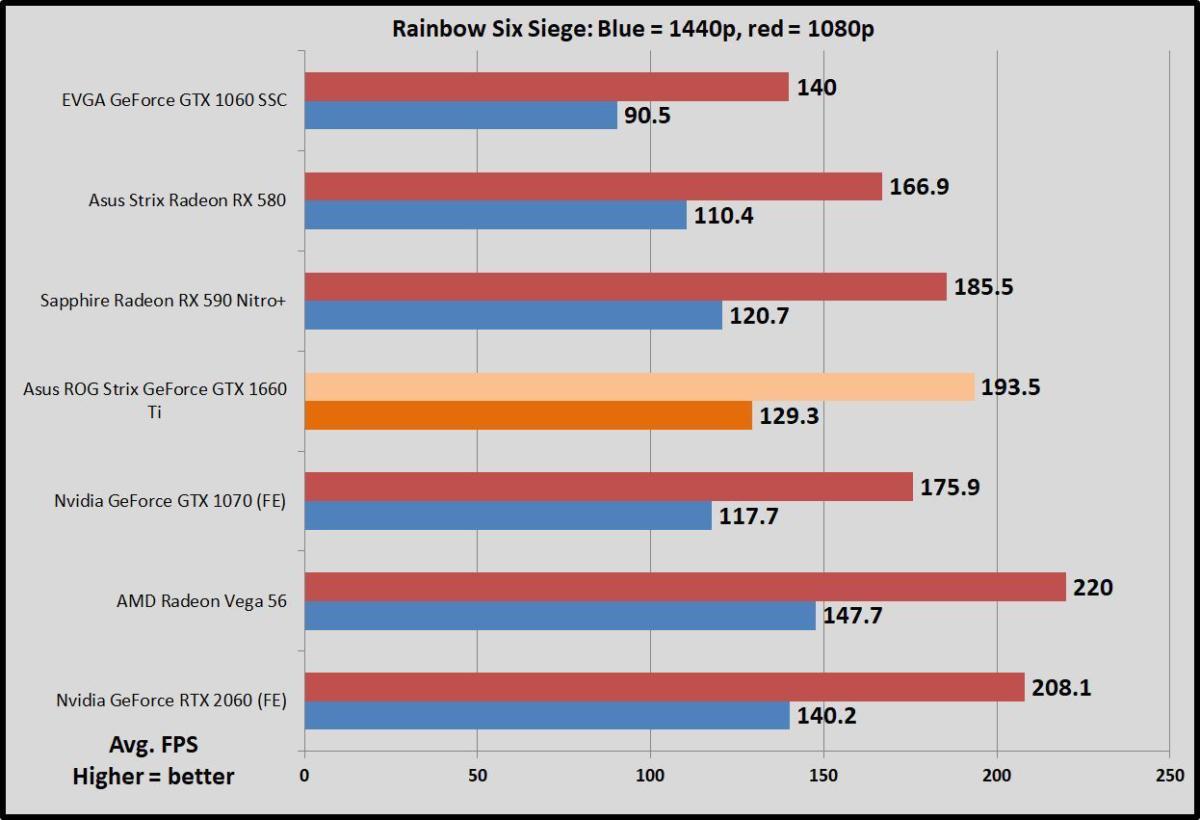 Brad Chacos/IDG
Brad Chacos/IDG As such, Nvidia's Alan Mathison Turin-based GPUs well outpace their predecessors, with the ROG Strix outpunching the GTX 1060 by a whopping 40 percentage. The Radeon RX 590 hangs close, but trails Nvidia's newcomer past a noticeable margin—at least along paper. Actually, you'd be difficult-pressed to pick unsuccessful the differences betwixt the frame rates for the two card game.
Next Sri Frederick Handley Page: Power, thermals, noise, and synthetics
Asus ROG Strix GTX 1660 Ti power draw, thermals, and noise
We also tested the Asus ROG Strix GeForce GTX 1660 Ti and its competitors using 3DMark's highly respected Flame Strike synthetic benchmark. Fire Strike runs at 1080p, Fire Impinge on Extreme runs at 1440p, and Fire Strike Ultra runs at 4K resolution. All render the same scene, just with more intense graphic effects as you proceed in the lead the scale, so that Extreme point and Extremist flavors stress GPUs even more. We record the graphics score to eliminate variance from the CPU.
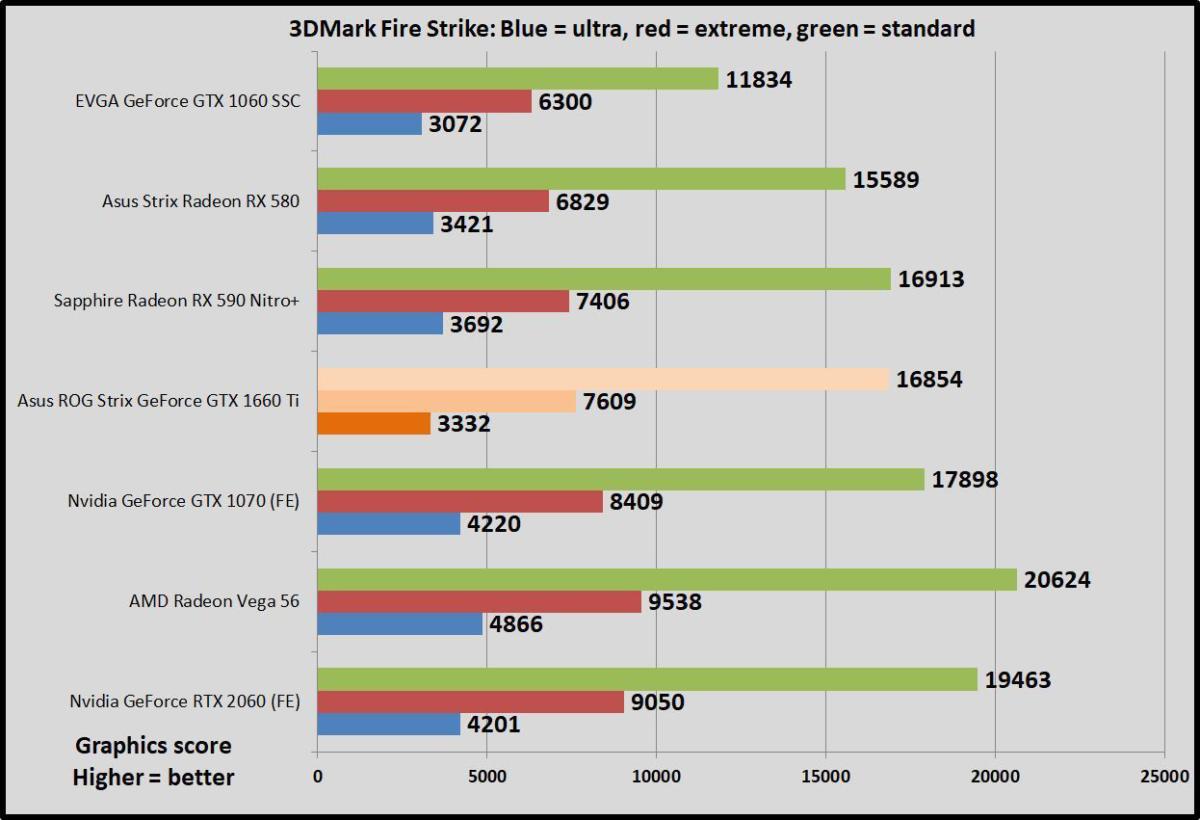 Brad Chacos/IDG
Brad Chacos/IDG This is why you can't test cards settled solely on synthetic benchmarks, though they're wonderful for relative sanity checks and competitive overclocking contests. Reported to Fire Strike, the GTX 1660 Ti is slower than the Radeon RX 590, and well in arrears the GTX 1070. That only isn't on-key in actual games.
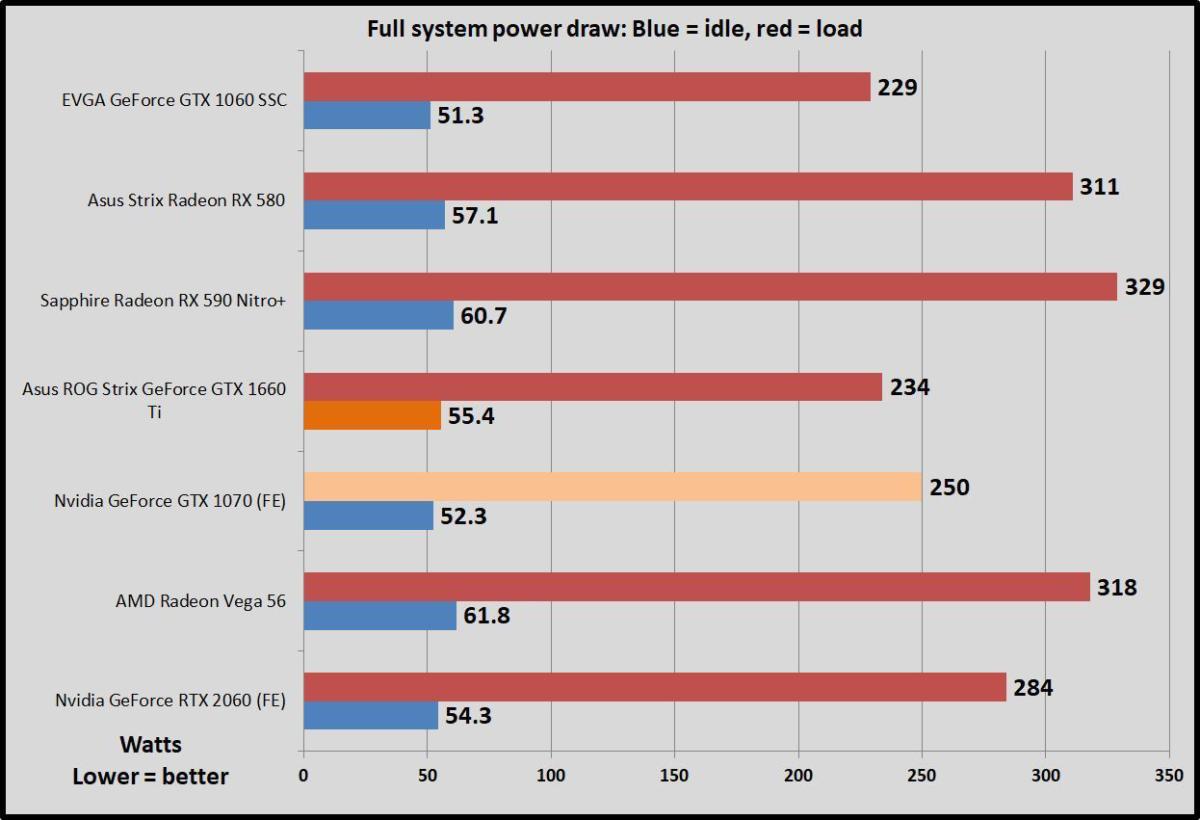 Brad Chacos/IDG
Brad Chacos/IDG We prove power draw away looping the F1 2018 benchmark for about 20 minutes aft we've benchmarked everything else, and noting the highest recital along our Watts Up Pro meter. The first portion of the race, where all competing cars are onscreen simultaneously, tends to be the most demanding portion.
The GeForce GTX 1660 Ti is another testament to the incredible power efficiency of Nvidia's GPU architectures. Even with its RGB LEDs, trio of fans, and grueling overclock, the ROG Genus Strix draws roughly the same amount of power as EVGA's overclocked GTX 1060, but delivers more higher performance. AMD's bill can't even fall close to Nvidia's in terms of untoasted power efficiency, either.
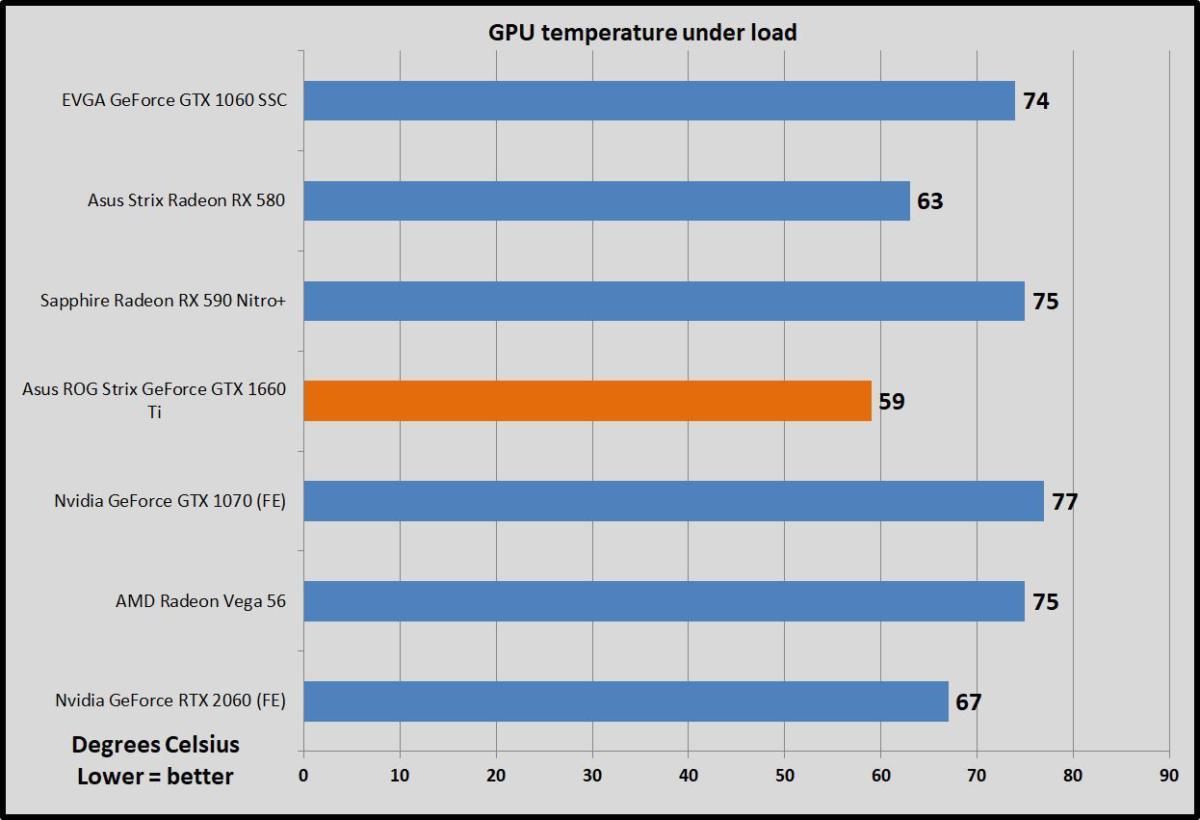 Brad Chacos/IDG
Brad Chacos/IDG We test thermals by leaving HWInfo's sensor monitoring tool vulnerable during the F1 2018 5-lap major power draw test, noting the highest maximum temperature at the end.
Sweet beatified moly. The Asus ROG Strix GTX 1660 Si's default Performance BIOS keeps the GPU perfectly frigid, and it doesn't get too vocal in the work. If you prefer silence, swapping to the Quiet BIOS delivers that in exchange for temperatures rising to right around 70 degrees Celsius—which would even pull round one of the coolest graphics cards in this price range. The custom cooling result that Asus uses on ROG Strix graphics cards may be large and pricey, but it delivers absolutely wonderful results.
Next varlet: Should you corrupt the GTX 1660 Ti?
Should you buy the GeForce GTX 1660 Cordyline terminalis?
Decidedly, and doubly so if you have an ultra-fast refreshen rate 1080p ride herd on.
Move over Radeon RX 590: Nvidia's $280 GeForce GTX 1660 Titanium is hands-down the best 1080p graphics card you can purchase now, trouncing its AMD rival in both performance and tycoo efficiency. Asset, it handles 1440p gaming on a equality with the GTX 1070, a previous pinch pick in that class, and plays nice with affordable FreeSync monitors now. The GeForce GTX 1660 Ti kills, period.
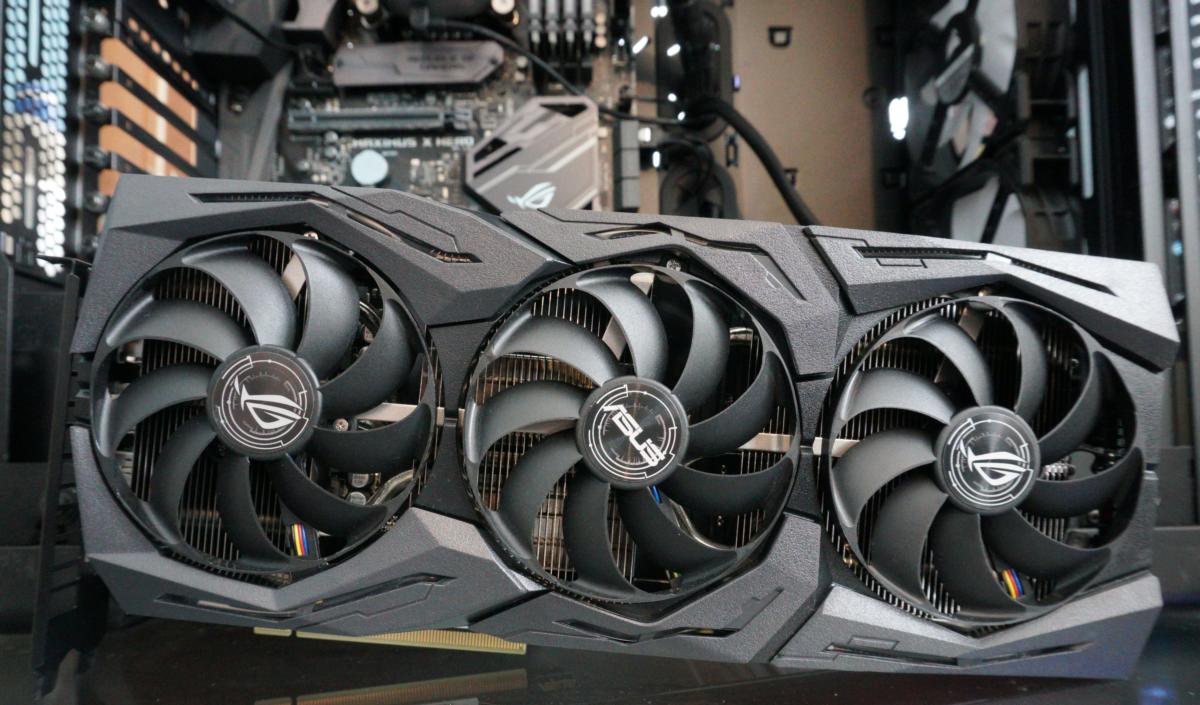 Brad Chacos/IDG
Brad Chacos/IDG You shouldn't buy it in every circumstance, though.
While Nvidia's graphics card holds up the right way at 1440p, if you're buying a new graphics card specifically for that resolution, we'd probably recommend spending the extra money on a $350 GeForce RTX 2060. Its lead isn't significant in every game we tested, just it maintains a noticeable performance advantage in most titles. That additional legroom will enter handy at the high resolution as time goes on. The RTX 2060 contains stylish ray tracing and AI-enhancement features that the GTX 1660 Ti lacks as good, though game reenforcement for RTX technologies have been slow to straighten.
Along the flip sidelong, the majority of gamers use 1080p monitors, and a big chunk of those are spouting at 60Hz. If that's your situation, the GTX 1660 Ti might be overkill. With the older Radeon RX 580—not the more mighty Radeon RX 590—still delivering a good 1080p/60 gaming experience on Ultra or Advanced graphics settings, we'd recommend leaning in that focus, especially since 8GB versions of the card tail most always be found marketing for $200 or less these days. That's a full $80 to a lesser degree the MSRP for the GTX 1660 Ti, or $130 to a lesser degree this ROG Strix version of it, and the Radeon RX 580 testament still give you a grand gaming experience happening a 60Hz screen.
Avoid the Radeon RX 590 for now. Prices for it have dropped slightly, from $280 to $260, but the GTX 1660 Ti beats it silly in every way.
If you're coming from a GTX 960 or older GPU (which sadly, we didn't wealthy person time to bench mark), the GeForce GTX 1660 Ti bequeath be an utterly massive ascent. While it's quicker than the GTX 1060 by a healthy 25 to 50 percent in all but games, upgrading from its direct predecessor is less enticing. You usually privation to skip a generation if you'Ra staying in the same cost range.
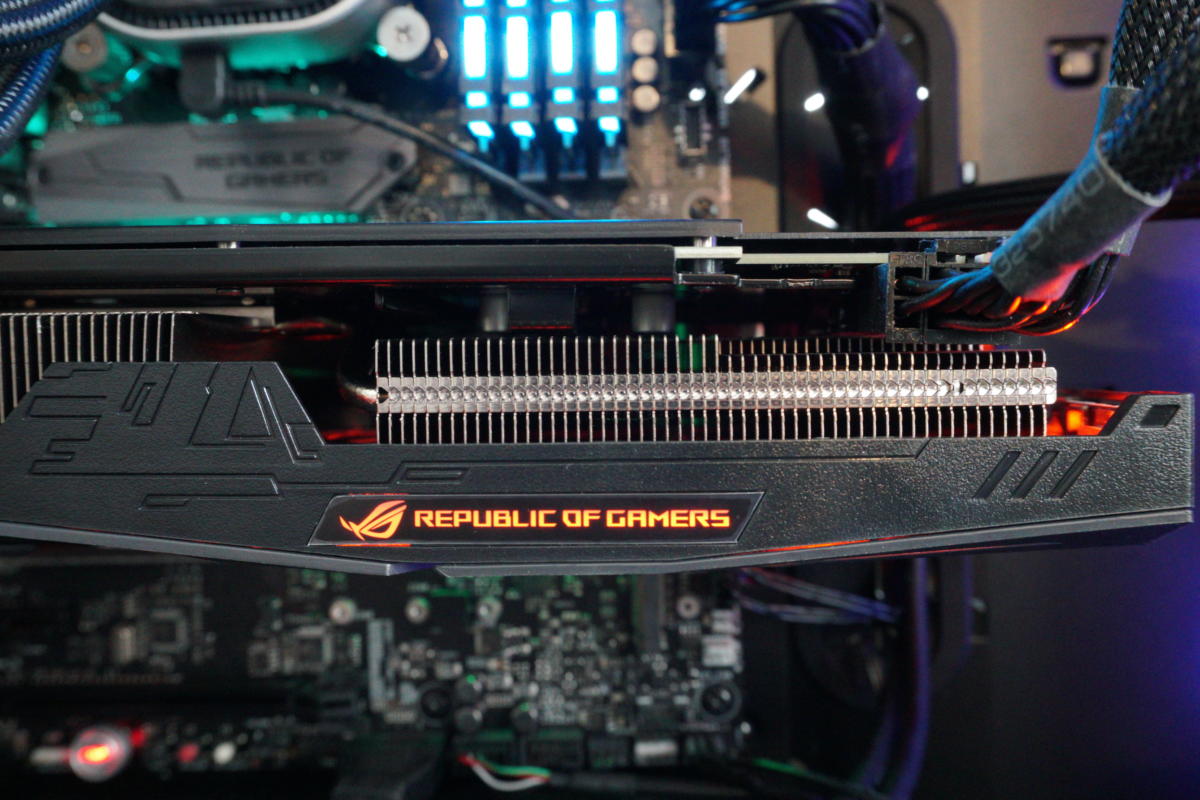 Brad Chacos/IDG
Brad Chacos/IDG As far as the $330 Asus ROG Strix GTX 1660 Ti itself goes, it earns our hearty recommendation—and an Editors' Choice award.
We oasis't tested a $280 version of the GTX 1660 Ti yet, simply even if carrying out for the cheaper models winds up in the same ballpark with some tweaking, this posting easy justifies its $50 price premium. The sizeable overclock and even higher out-of-the-box performance is nice, but it's the Strix's monstrous cooler and deep array of value-adding features that impress the most. That potent tank unlocks tantalizing scenarios that most other cards can't match in the form of double-BIOS profiles that countenance you choose 'tween frappe-cold temperatures and great noise levels, or effectively silent noise levels with still-swell thermal results. I can't state enough how big of a quality-of-life win that is in actualised expend. 2 drawbacks: You'll need a lot of space in your caseful to accommodate this beast, and the price premium pushes the ROG Strix out of the sub-$300 stray that most gamers moot the mainstream sweet spot.
Don't let that deter you if you can swing it, though. The Asus ROG Strix GTX 1660 Cordyline terminalis is damned near the crowning version of an absolutely sensational graphics identity card—level without ray trace.
Note: When you purchase something later clicking links in our articles, we may earn a teeny commission. Read our affiliate link insurance policy for more details.
Source: https://www.pcworld.com/article/403349/asus-rog-geforce-gtx-1660-ti-review.html
Posted by: dowdywoulty.blogspot.com


0 Response to "Asus ROG Strix GeForce GTX 1660 Ti review: GTX is back with a vengeance - dowdywoulty"
Post a Comment